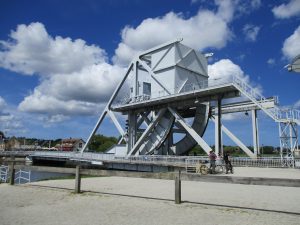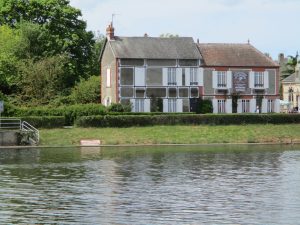Our next stop on this study tour was Bayeux, France. This is a small, quaint town in Normandy. A place where crime is nonexistent, laundry is eighty-five cents for every five minutes and it is impossible to find an open restaurant at 4 pm on a Sunday. Despite my laundry meltdown and lack of bread and cheese for a few short hours, I really liked this location.
As a group, we visited the Bayeux tapestry. It was wonderful. The tapestry is 230 feet long and 20 inches wide. When you walk alongside it while listening to the audio device they provide, you get to hear the story of Harold and William fighting to be King of England. Each scene is numbered so you follow in order as the audio narrates the story and points out specific images to look at. It would say, “Notice how Harold has his hands on different holy relics while he swears his allegiance to William. William was concerned that Harold might betray him so he wanted to ensure that the oath was binding.” Pointing out these specific images was helpful when we reached the end of the story.
Harold promised to recognize William as King of England in front of God and when he betrayed William, he suffered the consequences in the battle for England.
Another reason I enjoyed the tapestry was that I understood some of the language written on it. I studied Latin for four years in high school and that helped me translate some simple words before the audio explained what was happening. That’s part of why I loved the tapestry so much. I felt connected to it since I could translate the language when in Bayeux I did not understood what people said in French.
On our second day in France, I had to give a site report on a specific book I read which covered a topic in WWII. I decided to read Pegasus Bridge by Stephen Ambrose.
It follows Major John Howard and his team as they execute Operation Deadstick. My report was nerve-racking. While I was excited to share their story, it was intimidating to talk in front of my peers about a topic I cared so much about. I stood in the exact location that Major John Howard and his team landed three Horsa gliders to capture the Bénouville Bridge (later renamed Pegasus Bridge in honor of the 6th Airborne Division) on June 6th, 1944. Their story is incredible. The timing of their landings was so exact and they overcame the Germans guarding the bridge within ten minutes of their arrival. How could I do the story justice? I was standing next to the bridge, across the river from Café Gondrée and it was as if the pages of the book came to life.
I’m mentioning the café, which might seem unrelated to a military operation, because the Gondrée family did reconnaissance for the Allies before they landed the gliders on D-Day. That café has been around for over seventy years. According to Ambrose, the Gondrées were the first people liberated in France. Seeing the café made me feel more connected to the site than seeing the bridge. It truly was an amazing experience.
During our stay in Bayeux, we visited three cemeteries. One honoring the German soldiers who died in battle, another honoring American soldiers, and the last one which honored British soldiers. They all differed from each other.
In the case of the Germans, they lost the war. I felt as though their cemetery centered on respecting and honoring the dead. There was no focus on glory or success. German graves were very simple. Several young men would be listed on the same stone. The only information was their names and their date of birth to the day they died. It was terrible that so many teenagers were in those graves. Despite the terrible actions of the Nazis, I still value life and the young men were barely able to live theirs. I was most affected by the soldiers who died between the ages of fifteen and seventeen. I have two brothers in that age range. I hate to think what would have happened to them if we lived during the war.
The following day we visited the American cemetery. Unlike the German graves, these were large and honored each individual soldier. Even the unidentified men received a tombstone. The cemetery was packed with people paying their respects whereas the German cemetery was rather empty. For America, WWII was labeled “The Good War” and as a result, soldiers were honored for their glory and bravery. We won so our soldiers were our champions. There’s a quote I found about this cemetery that I want to share:
“There’s a graveyard in northern France where all the dead boys from D-Day are buried. The white crosses reach from one horizon to the other. I remember looking it over and thinking it was a forest of graves. But the rows were like this, dizzying, diagonal, perfectly straight, so after all it wasn’t a forest but an orchard of graves. Nothing to do with nature, unless you count human nature.” -Barbara Kingsolver
I believe it does a great job of describing the graves while also emphasizing the tragedy that comes with war. Young, brave soldiers died. This included several Ohio State students. I placed a flag on the grave of one. It is crazy to think that he had gone to the same school I attend currently, but he never made it home.
Lastly, we visited the British Cemetery. For the British, WWII was “The People’s War.” The graves reflected this sentiment in the sense that they were all individualized. For the American graves, they were all the same. The only differences were that the headstones either had a cross or star of David on them. The British cemetery recognized all religions. Family members could customize what they wanted the graves to say. The focus was on each soldier which was something that we did not see in the American or German cemeteries.
Next stop, Paris.






